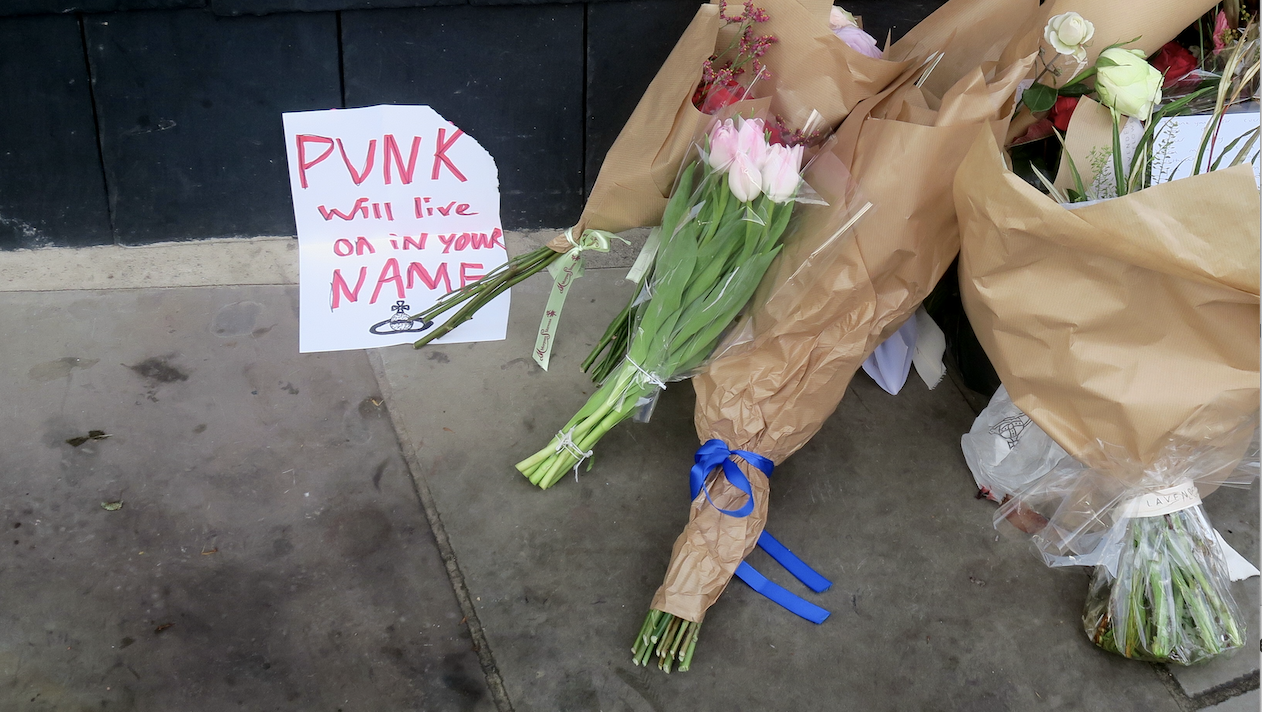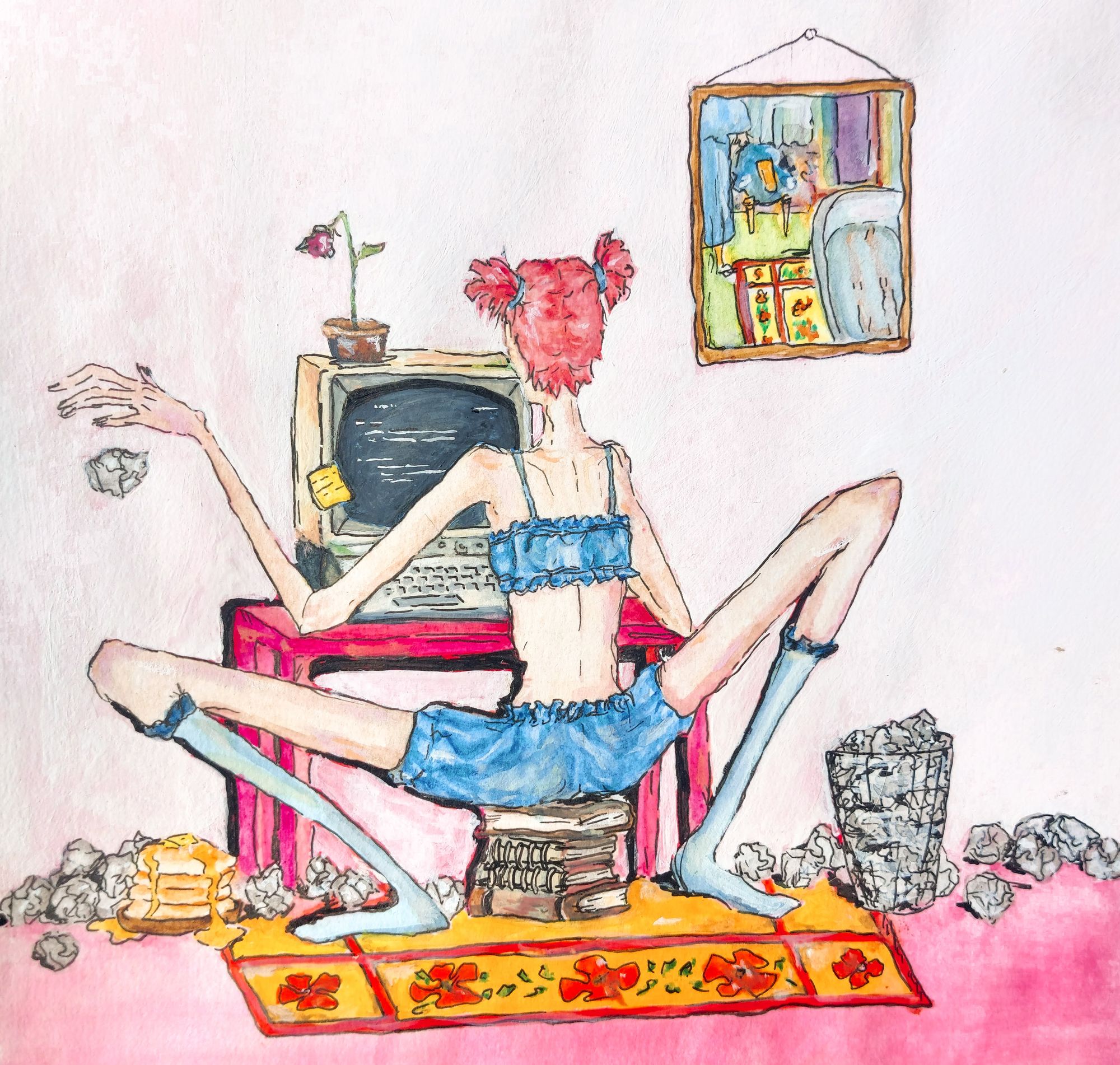
What’s in a name?

(Image: Flowers placed outside Vivienne Westwood’s famous shop at 430 King’s Road, Chelsea, London, after her death in December 2022.)
When you google Alexander McQueen, you are met with a couple of options. First and foremost you can ‘discover handbags and ready-to-wear for men and women from the house of Alexander McQueen’. Surprisingly, it is only after much scrolling that the Wikipedia for Lee Alexander McQueen can be found. Why? Name brands have such dominance in fashion, to the point that they swallow and consume the person after whom they are named. Whilst designers are often inflated and canonised, it takes on an entirely new level after their death. Names can and are used in perpetuity. Work that is not the designer’s own is shown under their name and sold to millions. Perhaps this is expected in life, but in death it takes on a more sinister air.
I have always experienced fashion through people. From fashion students to designers, to models, to seeing my mum has bought something new, fashion is about people. Pierpaolo Piccioli, former Creative Director of Valentino, famously (and rather unusually for the industry) took his bow at shows with the seamstresses and tailors of the couture atelier. The sheer amount of physical space they occupied on the runway was astonishing. It’s not uncommon to hear of dresses that took people an unfathomable amount of time: Gigi Hadid’s Thom Browne creation for the Met Gala took a team of 70 people over 13,500 hours. While the phrase ‘it takes a village’ may be loaded with faux sincerity and cliché, it aptly captures the enormous team of people behind every show and every collection. Fashion is about people.
But, fashion is also about names. From Gucci to Balenciaga, Valentino to Louis Vuitton, people buying and practising fashion are in constant contention with the designers of the past. These names are used chronically, perennially. These names drive billions of pounds of economic activity per year. These names spawn awe, respect and intrigue. What is the value in them? They serve as guaranteed luxury, as a certain high level quality and a particular style echoing the designer’s tastes, artistic vision and designs. I just don’t think it is fair or ethical in many cases to continue to use and profit from a designer’s name after their death. It is a chance to become an icon, a byword for excellence and creativity. But it also robs you of the control you once had over your image.
Both the people Alexander McQueen and Vivienne Westwood previously declared their brands, ‘Alexander McQueen’ and ‘Vivienne Westwood’, should die with them. When asked in interviews what would happen after his death, McQueen replied jokingly “just burn the place down!”. He often discussed the deeply personal nature of his work, and the fact that nobody could make it in quite the same way. His AW97 collection ‘It’s a Jungle Out There’ responded to criticisms of his work at Givenchy and the feeling of being hunted. In his earlier collections, McQueen sewed his own hair into the label, emphatically and literally putting his DNA into the work.
With Westwood (and indeed other designers for whom this happened) there are, in some senses, two deaths: one of body and one of principle. Westwood believed her label should be closed after her death; ownership was important to her. She had said previously that getting to own her company meant she “never had businessmen telling me what to do or getting worried if something doesn’t sell.” And it worked – her part in stylising the punk movement really cannot be overstated. Despite her previous belief that the brand should die with her, her husband, Andreas Kronthaler, took over as Creative Director following her death in 2022. While clearly not Vivienne Westwood, his collections are a touching tribute to her and their life together. His SS24 collection, titled 43 Old Town (after the house they shared) was based entirely on Westwood’s personal wardrobe. Isn’t that beautiful? Westwood’s fashion was inimitable. For Kronthaler to recognise he could not hope to recreate it, and look to her for inspiration, is a striking act of devotion and loyalty. Collections for the brand designed by him are – in a sweet and fitting way – marketed as ‘Andreas Kronthaler for Vivienne Westwood’.
This is not always the case. The story of Cristóbal Balenciaga is quite different: the son of a seamstress and a fisherman, he worked from the age of twelve to establish his brand. In creating his pieces, he started not with illustrations but by feeling the fabric. His silhouettes and the constructions of his pieces defined the 1950s – veering wildly away from Dior’s ‘New Look’, his work was daring and avant-garde, with fabric draping and moulding in ways that were fluid, elegant, and functional. After declaring in 1968 that it was impossible to create couture, he closed his namesake company and died four years after. In 1986, his name was bought, and Balenciaga continued trading. The revival from 1986 onwards is – to put it lightly – not completely in his spirit. There remains a sense of interesting construction, but the elegance and originality has faltered somewhat. A dress worn by Kim Kardashian, a brand ambassador, was styled with the price tag. They released a Crocs heel, and a torn (distressed being too light a word) hoodie for $2,043. Is this in Cristóbal Balenciaga’s spirit? The period of extinction, in which nothing was released and Balenciaga’s label had effectively died with him, allowed Cristóbal’s legacy to form and other designers were endlessly inspired by his work. As a result, his name held a completely different currency to what it does today. His legacy and Balenciaga’s legacy are completely different, in all but name.
Either way, do people care? I decided to ask Jess Turner, friend and fashion student at the University of Loughborough. She emphasised their domination in the industry and the fact that whilst the prevalence of designer brands is often stifling, it creates a scale of achievement – an Alexander McQueen internship is a huge honour for a fashion student. When asked if she thought named houses should continue after the death of their namesake, she argued that it depended primarily on their wishes and who took over. McQueen’s long-time collaborator Sarah Burton took over after his death, having worked side-by-side with him for years. Arguably, she probably knew his work process better than anyone else. And yet, his previous desire to have his label closed, and the fact that it wasn’t, creates an issue.
I also thought it pertinent to ask someone who didn’t care about fashion houses or about Cristóbal Balenciaga or any of it. My boyfriend–the best control variable there is–fell along similar ethical lines to Jess. My hard-hitting and formal interview–which took place in the car on the way to Winchester–was punctuated with insights such as “I don’t understand the fashion industry… I think they all dress up in silly dresses” and “I think everyone would be much happier if everyone wore Hawaiian shirts”. He told me he thinks of name brands largely as assurers of quality rather than creative output. However, in cases where the brand’s namesake is against the continuation of the brand, he believed it was unethical. In this sense it may not be a fashion issue, but rather a moral and ethical one that affects everyone.
But really, what’s in a name? ∎
Special thanks to Christopher Wahlen and Jess Turner.
Words by Kelsey Moriarty. Image courtesy of Wikimedia Commons.







